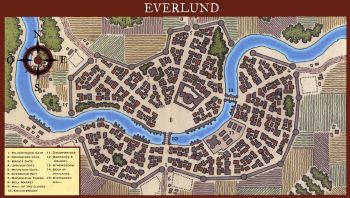Everlund
Everlund
|
Geographical Information
|
| Size: Large City • Location: Silver Marches |
Societal Information
|
| Populace: 21,000 • Human 48%, Elves 21%, Half-elves 14%, Halflings, Lightfood 9%, Shield Dwarves 7%, Others 1% |
| Religion: Temples: Helm, Mielikki, Corellon Larethian, Shiallia • Shrines: Oghma, Shaundakul, Waukeen |
| Imports: Ale, armor, cheese, clothing, fruit, grain, sugar, weapons, wine |
| Exports: Amber, charcoal, furniture, furs, stone, syrup, timber, valuable ores |
Political Information
|
| Government: Oligarchy |
| Ruler: Council of Elders |
| Military: Army of the Vale |
Everlund is a city of merchant traders and caravan teams and is one of the greatest supporters of the league of the Silver Marches. Located southeast of Silverymoon and situated on the north bank of the River Rauvin, Everlund is the second largest city in the Silver Marches and one of its most active mercantile communities.
History
The walled city was resettled by humans from Ascalhorn on the site of Besander's Blockhouse in 515 DR. Since its humble beginnings as a fortified trading outpost and bridgehead on the Rauvin, the city's population and importance increased so that it became one of the most important trading cities in the region.
Government
For nearly five hundred years, Everlund has been ruled by the Council of Elders. This group is composed of the people holding the most prominent positions in the city, although there was occasional debate over whether some civic figures were important enough to merit a seat on the council. The council is led by the First Elder, an office granted by vote of the others. The First Elder holds this position until another member challenges it; sometimes this post was held for many years, other times a few days.
Militia
The city is defended by the Army of the Vale.
Places of Interest
The Bell Market was the economic and social center of Everlund.
Official
- The Great Armory: A walled compound overlooking the waterfront that serves as a barracks. The Hall of the Elders was where the Council of Elders met and was located on the east side of the Bell Market. The Hall of Records and the Hall of Redress were the courts of Everlund.[7]
StoresEdit
Everlund was home to The Bent Bow, an archery shop, and Hethmeir's Highboots, a boot shop.[8] TavernsEdit
Taverns in Everlund included The Dreaming Dragon, a tavern frequented by elves and halflings, and The Stag at Bay, a bar that catered to hunters and adventurers.[9] OrganizationsEdit
Moongleam Tower was the Harper base in Everlund.[10] Bridges and gatesEdit
The two bridges in Everlund were named Knightbridge and Dwarfbridge, both of which crossed the River Rauvin.[citation needed]
The five gates of Everlund were open from dawn to dusk and shut at all other times. They were named Bridge Gate (the start of Evermoor Way), Downriver Gate, Mountain Gate, Silvermoon Gate (the start of the road to Silverymoon) and Upriver Gate (the start of the trail to Sundabar).[11] Temples and ShrinesEdit
Evergreen Hall was a temple of Mielikki. The Grotto was an area devoted to Shiallia. The Keep of Vigilance was a temple of Helm. The Starmeadow was an area devoted to Corellon Larethian. Also located in Everlund were shines to Oghma, Shaundakul (popular with the caravan masters), and Waukeen.[citation needed] Trade routesEdit Roads and trailsEdit
Everlund was the final destination on the Evermoor Way, the primary trade route from the south and west.[12] The road to the north, eventually reaching Silverymoon, passed through Everlund Pass at the western end of the Nether Mountains. Trade to the east traced the banks of the River Rauvin, reaching Sundabar as its final destination. Points of interest along this trail (in order from Everlund to Sundabar) included Hilltop, Jalanthar, Lhuvenhead, and Rauvincross.[12] RiverEdit
Downstream travel on the River Rauvin was blocked by the Striding Giant Rapids. Upstream travel on the River Rauvin was possible for about 170 miles (274 km) to Sundabar.[13]
